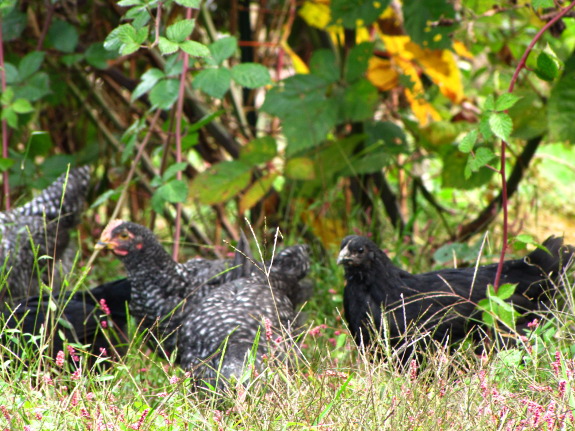
Free range chicken experiments

Last year, I
summed up all of the chicken experiments I'd been posting about
throughout the year on our Avian Aqua Miser site, and I thought you might
enjoy seeing the highlights again this year.
 One of the most timely
experiments I wanted to mention involved letting
our chickens free range in the woods over the winter. I was fascinated to
see that the flock concentrated most of their attention around the
bases of big trees, where they scratched through the mulch in search of
invertebrates. They only foraged over about three quarters of an
acre, probably because the flock had to stay close enough to the hen
house so that ladies could drop by at intervals to lay their eggs.
One of the most timely
experiments I wanted to mention involved letting
our chickens free range in the woods over the winter. I was fascinated to
see that the flock concentrated most of their attention around the
bases of big trees, where they scratched through the mulch in search of
invertebrates. They only foraged over about three quarters of an
acre, probably because the flock had to stay close enough to the hen
house so that ladies could drop by at intervals to lay their eggs.
The
forest worked as a good escape valve in the summer too, when the grasses stopped
growing and the ground began to look bare in their rotational
pastures. I think this system really depends on a quality
rooster, though, since when I tried the same trick with some  half-grown broilers, they
just sat on the other side of the pasture fence and begged to be let back
into their home turf.
half-grown broilers, they
just sat on the other side of the pasture fence and begged to be let back
into their home turf.
If you start
young chicks free ranging from week one and keep them close to the
house, they're the very best chickens to let run semi-wild. Having
trees or bushes available to hide in makes chicks (and
adult hens, for that matter) feel safer, so they spend more time
hunting wild food.
 There
are reasons we don't let our main flock free range all the time, though. The book Free-Range
Chicken Gardens
gives some tips for helping chickens coexist with a garden during the
growing season, but we like to keep the garden extremely productive, so
the chickens get relegated to pastures after they reach two months
old. We were forced to clip
a couple of chickens' wings (and then eat one of them)
when they didn't toe the line and thought the garden was still fair
game during the summer months.
There
are reasons we don't let our main flock free range all the time, though. The book Free-Range
Chicken Gardens
gives some tips for helping chickens coexist with a garden during the
growing season, but we like to keep the garden extremely productive, so
the chickens get relegated to pastures after they reach two months
old. We were forced to clip
a couple of chickens' wings (and then eat one of them)
when they didn't toe the line and thought the garden was still fair
game during the summer months.
I don't feel like we
have much more experimenting to do with free range chickens. Our
system just works!
| This post is part of our 2012 Chicken Experiments lunchtime series.
Read all of the entries: |
Want more in-depth information? Browse through our books.
Or explore more posts by date or by subject.
About us: Anna Hess and Mark Hamilton spent over a decade living self-sufficiently in the mountains of Virginia before moving north to start over from scratch in the foothills of Ohio. They've experimented with permaculture, no-till gardening, trailersteading, home-based microbusinesses and much more, writing about their adventures in both blogs and books.
Want to be notified when new comments are posted on this page? Click on the RSS button after you add a comment to subscribe to the comment feed, or simply check the box beside "email replies to me" while writing your comment.

We have a very real problem with coyotes and bears here. And even a good solid coop doesn't even begin to deter a hungry bear. We had one rip off a piece of sheet metal with which we had reinforced our door - just like it was a piece of cardboard. And another ripped our gate off it's hinges and split the post all the way to the ground. A neighbor lost 13 birds in one day from a single coyote- or possibly a pair- who just kept coming back and climbing a 6. Foot fence and dragging off hens. And then there's the neighbors pit bull who gets loose. So for now, I have taken to only letting them out a few hours before dusk, and I pretty much stand guard over them until they return to roost. We are in the process of digging fence posts for a large fenced enclosure, and I hope to be able to let them out in that when it's done.
Funny how quickly they learn- they seem to know exactly what time I am coming to let them out, and they are all standing by the door waiting.